"Shangqiu farming" raises peacocks in rural areas. If you raise peacocks in this way, you can earn at least 200000 a year!
1. Venues and fences
The peacock is timid and scared, requiring the environment to be quiet and the site clean and dry. Any noise and sudden high-frequency sound will cause the flock to be disturbed and make frightened calls: if frightened during egg laying, the egg laying rate and fertilization rate will immediately decrease. The place where peacocks are raised should be in a place with dry terrain and quiet environment. The structure of the fence house is mainly considered to have good lighting, dry fence house and ample activity space, etc. On average, each bird has an active area of about 8 square meters, including 1x3 sunshade and rain shade, 2 canopy for sports ground, 2.5 meters above the ground to cover fish nets, fence with iron net or dense bamboo bars around the fence, iron net is best used below 1 meter high near the ground, and the frame of the fence house can use angle iron, water pipe and other characteristics. A beam frame (iron or bamboo) is set up about 1.3 meters above the ground in the playground for peacocks to inhabit. In order to keep the fence house dry and provide peacock sand bath conditions, the sports ground should be covered with coarse sand layer 3-5 cm thick. Fruit trees can also be planted outside the playground to shade the sun.
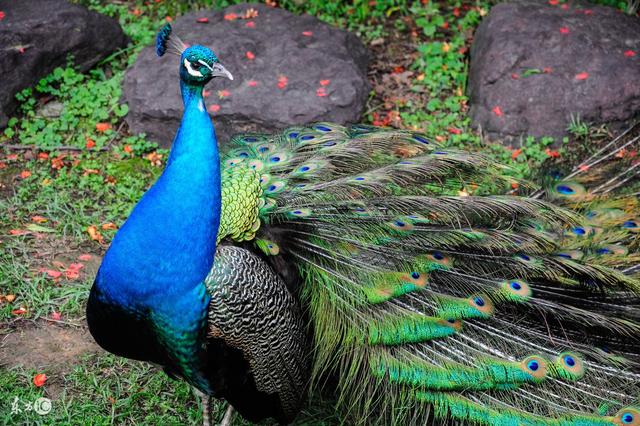
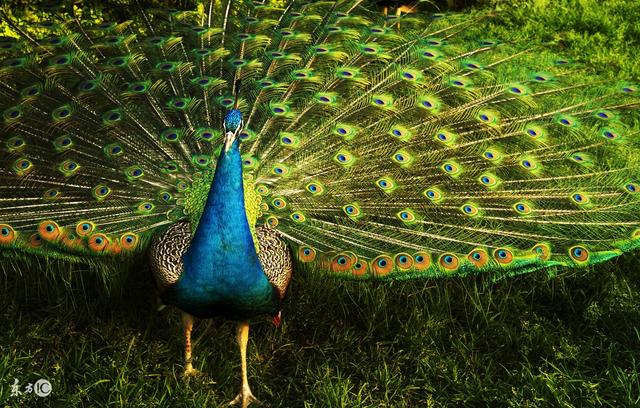
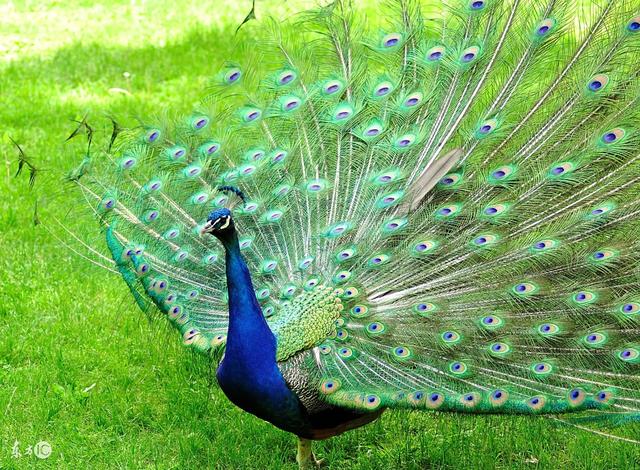
two。 Feeding and management
The peacock is large in size, vigorous in metabolism, full of feathers and colorful. The rudder feather of the male is 1.1 meters long, and the main wing feather is 35 centimeters long and 6 centimeters wide.
Peacock coarse feeding, beans seeds, poultry eggs, insects and other extensive feeding, during the laying period, we mainly breed eggs, supplemented by wheat, corn, sorghum, peas, mung beans, bamboo beans, etc., and supplemented with a small amount of yellow powder insects, duck eggs (boiled) and other animal feed. At the same time, the fence should always be kept dry and clean, and there should be adequate drinking water and health care sand. In addition, a small amount of chopped green materials, such as Allium macrostemon and elephant grass, should be given every day.
The adult male finch is about 4.5 kilograms, and the female finch is 4.5 kilograms. The average daily intake is about 250 grams, the dietary crude protein is about 18% dietary protein, and the energy per kilogram feed is 2800 to 3000 kcal.
Peacocks are gentle, but should be wary of individual males who are ferocious and often hostile to strangers or keepers. Pay special attention to this kind of peacocks hurting people with their claws and beaks.
In order to make the birds grow healthily, the birds were dewormed once a year before winter, and the vaccine was selected and grouped and injected with Newcastle disease Ⅰ vaccine at the beginning of the next year.
3. Mating and breeding under normal circumstances, breeding finches can lay eggs at the age of 22 months and 24 months, and the laying time is from March to August. Generally, eggs are laid before and after the "sting" of the lunar calendar every year, and each female finch can lay 28 eggs. In order to ensure the fertilization rate, the ratio of male to female should be controlled at 1: 1: 2: 3, that is, only one male and 2: 3 females can be kept in each pen, and two males cannot be kept in one pen at the same time, otherwise, during mating, males fight with each other and affect fertilization. The best utilization life of peacocks is 5-6 years, which is longer, and the fertilization rate of breeding eggs decreases year by year.
Peacocks mainly mate at 8: 9 a.m. and 4: 5 p.m., males compete with each other before mating, and females send out courtship signals. At this time, the environment should be kept quiet and onlookers are prohibited. The laying time is mainly at 17: 21 p.m. every day, mostly in the sand in the sunshade corner of the fence, digging a small nest with claws, or artificially using old car tires and putting some straw in the middle to make nests to train peacocks to lay eggs. In order to reduce the pollution of breeding eggs, eggs should be inspected many times before 22:00 in the evening.
4. Incubation
When the artificially raised peacocks have poor nesting ability, low hatching ability, small number of breeding and small number of eggs, they can be hatched with nesting hens. Due to the larger peacock eggs (each weighing 100g to 110g), each hen can hatch 3 to 4 eggs. During hatching, manual help is used to turn the eggs twice a day. After 27 days of hatching, the hens can be used to raise their chicks.
When the peacock has a large number of eggs and a large number of eggs, it uses an incubator to hatch. The breeding eggs within 5 days after delivery are disinfected and hatched in time, the temperature of the incubator is maintained at 37.5 ℃, the relative humidity is 65% to 70%, and the general incubation time is 27 days.
The peacock egg has a large shell and thick shell, which is the result of the peacock's choice in nature, which makes it not easy to lose the egg temperature and damage in nature, which is beneficial for it to reproduce in the wild. In the case of artificial breeding and using an incubator, we should solve the problem of uniform heating of hatched eggs and turn the eggs once an hour in the early stage of hatching, which is conducive to the uniform heating of eggs and the normal development of embryos, and is also an important way to prevent embryos from adhering to eggshells. The eggs hatched for 25 days were transferred into the machine with a temperature of 37 ℃ and a humidity of 75%.
The chicks that have been hatched for 27 days but are unable to get out of the shell should be given artificial "midwifery". Carefully peel off the broken line of the eggshell to help the chicks get out of the shell, and the chicks will stay in the machine until their feathers are slightly dry before they are removed from the machine.
Someone should take turns on duty in the incubation, make good records, and adjust the temperature and humidity appropriately according to the changes of temperature and weather.
5. After the brood comes out of its shell, put it in the incubator, keep the temperature 30: 31 ℃ within 1-3 days, and keep it warm for more than 28 ℃ at the age of one week. Feed 0.4% potassium permanganate water first, and then feed chicken flower food and yellow powder insects. The chicks love to eat Tenebrio Molitor very much. after one week of age, they are put into a layer cage to raise their chicks (three layers). The cage is 1007040 cm. Ten chicks were raised in each grid at the age of 1 week and 2 weeks, 8 birds in each grid at the age of 3 weeks and 4 weeks, 5 birds in each grid at the age of 5 weeks and 8 weeks, and then transferred to the breeding pen with 12 birds in each column.
When raising chicks, a piece of disinfected gunny bag should be placed at the bottom of the cage, and it should be changed frequently, keep clean and dry, feed and supply water all day long in the trough and sink, properly add compound vitamin B solution to drinking water, supply yellow powder insects regularly every day, gradually supply green feed after 8 weeks of age, and be immunized with chicken Ⅳ epidemic in drinking water once at 5 weeks of age.
6. After 8 weeks of age, the chicks are raised in a breeding house with an area of about 30 square meters per column, raising 10 birds. The floor of the shed is covered with 3 centimeters of coarse sand to keep the house dry and provide sand bathing; the chicken feed is fed step by step with seeds and beans, and a little cooked duck eggs or yellow powder insects are fed daily for chopping green material once a day, and health care sand is placed in the shed.
The middle finch is raised to autumn and is about 6 months old. if it is used for food, it can be properly reared. After slaughter, the carcass is beautiful, the color is light yellow, the muscle layer is thick, the muscle fiber is young, the slaughter rate is 75%, the average feed consumption is about 15 kg, and the meat-to-meat ratio is about 1:4. The middle finch has been raised for about a year and a half and is becoming more and more mature. at this time, it is necessary to select individuals with normal growth and development, healthy feet and moderate pubic distance as backup finches, taking into account the arrangement of crown feathers and the color of neck and chest feathers.
- Prev
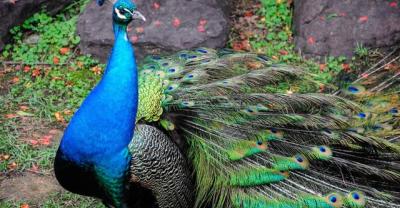
Is the honey produced by bee barrel culture better than that produced by barrel culture?
Many people who know a little about honey know that honey is brewed by bees collecting nectar, so we do not necessarily know the breeding of bees. ...
- Next
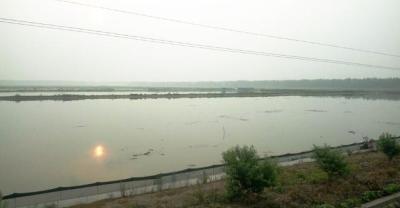
Crayfish culture process is standardized. If you want to know or prepare to breed lobster, you should learn it quickly.
Recently, many friends have consulted about the standardization process related to lobster farming, which has actually been shared a long time ago. I will re-edit the previous article today.
Related
- On the eggshell is a badge full of pride. British Poultry Egg Market and Consumer observation
- British study: 72% of Britons are willing to buy native eggs raised by insects
- Guidelines for friendly egg production revised the increase of space in chicken sheds can not be forced to change feathers and lay eggs.
- Risk of delay in customs clearance Australia suspends lobster exports to China
- Pig semen-the Vector of virus Transmission (4)
- Pig semen-the Vector of virus Transmission (3)
- Five common causes of difficult control of classical swine fever in clinic and their countermeasures
- Foot-and-mouth disease is the most effective way to prevent it!
- PED is the number one killer of piglets and has to be guarded against in autumn and winter.
- What is "yellow fat pig"? Have you ever heard the pig collector talk about "yellow fat pig"?

